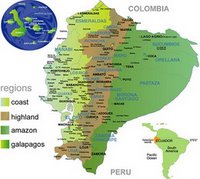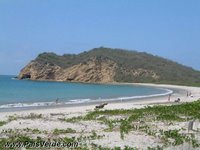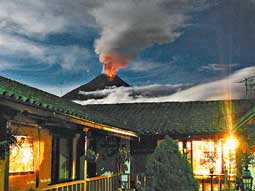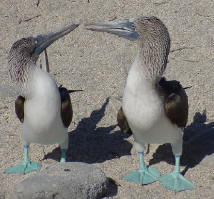After a presentation in June 2006. By Claudia Gonzalez.
Ecuador is a small country situated in the northwest of South America. In the north i

t is bordered by Colombia, at South and East with Peru, and west the Pacific Ocean. The presence of the Andes Mountain range and the maritime currents have generated variation in the climate and because of that we have three significant geographic regions: Coast, Highland, Jungle and Galapagos Islands, each one with its own different micro climate. Ecuador has an area of 256.370 square kilometres and around 12.000.000 habitants.

The coast is characterized by the beautiful beaches and the temperature of the water where every year the humpback whales come to mate. The weather is tropical- humid, the temperature is between 23 to 26 degrees and we have two seasons: a rainy season between December and May and a dry one from June to November. The people are open, they like to dance and have parties. They are also dedicated to agriculture of bananas, cacao, sugar cane, tropical fruits and especially to fish. They are specialists in delicious dishes with fish and coconut.
From the Coast to the Highlands you can travel around 10 hours by car and by aircraft is around 45 minutes. The Andes are characterized by impressive volcanoes, snow-capped peaks and lakes. The most impressive are the volcanoes Cotopaxi with 5911 m. and Chimborazo with 6310 m. The weather is dry between May and October and in the rainy and cold season between November to April, the temperature is between 13 to 24 degrees Celsius.
The Central highlands of the Andes were the seat of the Inca Empire. It stretched from the south of Colombia to the north. with the name “Tahuantinsuyo”. The Incas were a vast population of dozens of different ethnic groups with their own languages, customs and economies based on cultivation of the land. With the arrival of the Spanish in “Tahuantinsuyo”, Atahualpa “the Indian cacique” (the Indian king) was taken prisoner and this started heavy fighting between the Spanish and the Incas, who resisted being conquest.

For the Spanish, America represented a land full of riches, taken in the name of the Crown and they conquered the natives in a bloody manner. The Spanish used a variety of strategies, among which was indoctrination and the use of rival Indian chiefs.
Several different indigenous nationalities continue to live in their traditional lifestyles in rural villages and towns throughout the

nation. In the cities, you find many mestizos, African Ecuadorians, and whites. The people are dedicated to agriculture of corn, potatoes, all kind of vegetables and fruits, flowers and breeding of animals. The typical food is potato tortilla, roast pork and chicha (maize-based alcoholic drink).
The Capital Quito is situated in an Andean valley at 2,850m above sea level at the

foot of Volcano Pichincha (4,794m). Quito has been declared a Cultural Heritage of Humanity site by UNESCO for its architectural beauty, home of the numerous churches and convents built in the colonial period.
From Quito to the jungle, commonly know as the Amazon basin, you can travel around 8 hours by car or by aircraft around 40 minutes. This area is characterized by a lot of fast-flowing rivers, heavy rain and hot-humid weather, the temperature is between 23 and 36 degrees Celsius. The rainy season is between January and September and

the dry one is between October and December.
The indigenous tribes in the Amazon are Quichuas, Shuar, Achuar, Siona, Secoya, Cofan, Zaparo, and Huaorani, who don’t like to have contact with modern civilization. Each group

speaks its own language.
The Jungle has an extended variety of trees, flowers, orchids, medicinal plants and a great variety of mammals and reptiles as pink dolphins and caimans. The Amazonian dishes are base of yucca, Capibara meat, saino, turtle, guanta crocodile meat and boa meat, Fish such as peiche, catfish, bocachico, and piranha are also very popular.


The Galapagos Islands are situated a thousand kilometres off the coast of Ecuador. This archipelago has 125 islands and 5 of them are habitable and barren islands of volcanic origin which are about 3 to 5 million years old. The famous naturalist Charles Darwin found a sustained theory of the evolution and the origin of the species.
The Galapagos have a temperate climate. The temperature is between 22 to 32 degrees Celsius and is considered a natural reserve where the animals live in a natural environment near to humans. In certain areas it is possible to partake in both, deep or shallow diving and have contact with the aquatic species of the sea: coral reefs, whales, whale sharks, hammer head sharks, sting rays, manta rays, sword fish, turtles, sea lions.
Ecuador is a small paradise rich in natural resources, but due to the management of politics and the economy it is a poor country.
 I would like to introduce you to the city of Bujumbura, the capital of Burundi.
I would like to introduce you to the city of Bujumbura, the capital of Burundi. 





















 foot of Volcano Pichincha (4,794m). Quito has been declared a Cultural Heritage of Humanity site by UNESCO for its architectural beauty, home of the numerous churches and convents built in the colonial period.
foot of Volcano Pichincha (4,794m). Quito has been declared a Cultural Heritage of Humanity site by UNESCO for its architectural beauty, home of the numerous churches and convents built in the colonial period.


